info@gerb.com
Earthquake Protection with GERB Viscous Wall Damper
Discussions as well as experience show that damping is a crucial factor to reduce the destructive potential of earthquakes. GERB Viscous Wall Dampers (GVWD) are a special design of common Viscodampers®. They are installed in buildings and structures connecting different floors addressing shear deformation between them. In this position they are especially reducing interstorey drift ratios during wind or seismic excitation.
Seismic energy absorption through induced damping instead of intended damage
Earthquakes can have different effects on buildings depending on their duration, ground conditions and construction of the building. At the earth‘s surface, the earthquake waves cause the ground to move both horizontally and vertically. In particular, the horizontal forces released during earthquakes endanger the stability of structures. The consequences can be:
- Deformations and corresponding effects due to rapid movements from one direction to another
- Local damages (e.g. of non-structural elements like walls)
- Damaged doors and windows that can no longer be used
- Damage of important machinery where operation cannot be guaranteed
- No access to lifeline structures such as power or water
- Partial or complete collapse of the building
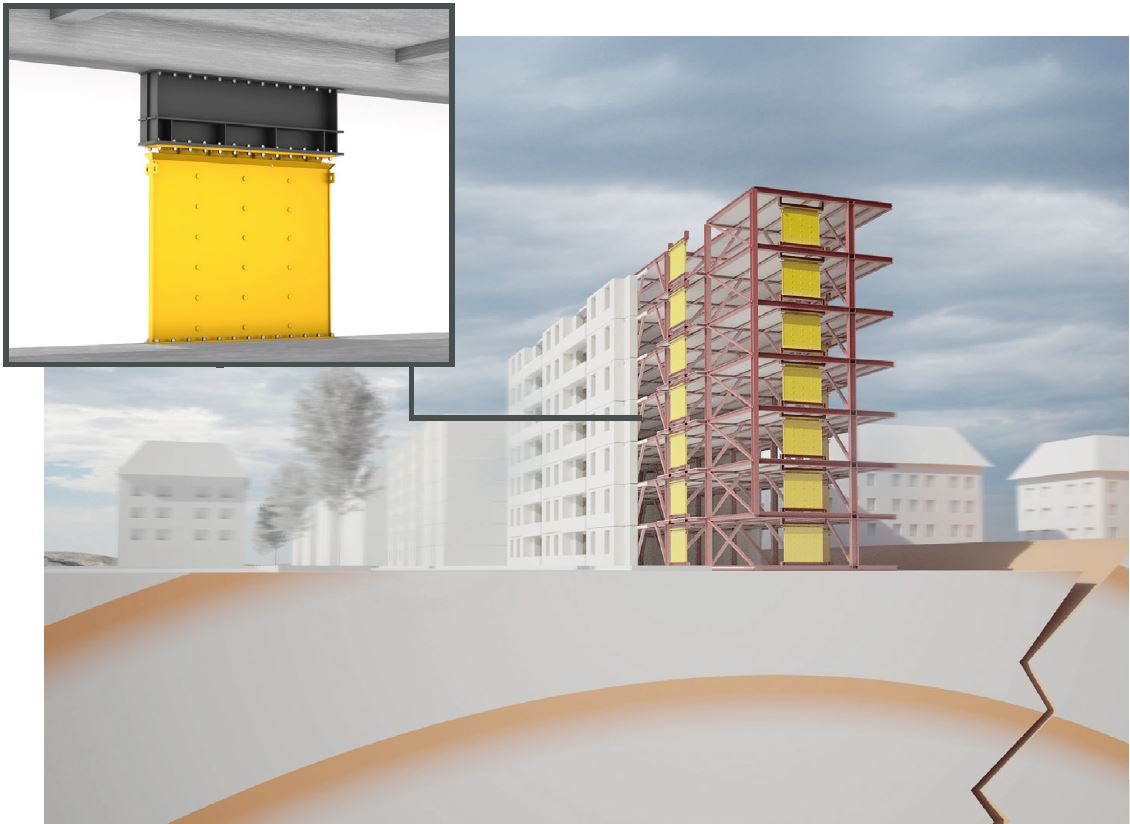
Seismic protection due to increase of damping
The main target of seismic construction standards is life safety. A safe evacuation of people must be guaranteed at all times. Appropriate construction measures help to significantly reduce the risk of collapse of a structure even during strong earthquakes. In addition, it is advisable to install seismic protection measures adapted to the conditions of structure and environment.
A damping solution using the latest technology can provide additional protection for structures in the event of an earthquake. The reduction of the induced structural responses by the increase of viscous damping can be taken from different national and international standards. Like illustrated in the figure, an increase of structural damping causes the reduction of the acceleration and thus of the earthquake impact on the structure. Seismic stress decreases with increase of damping.
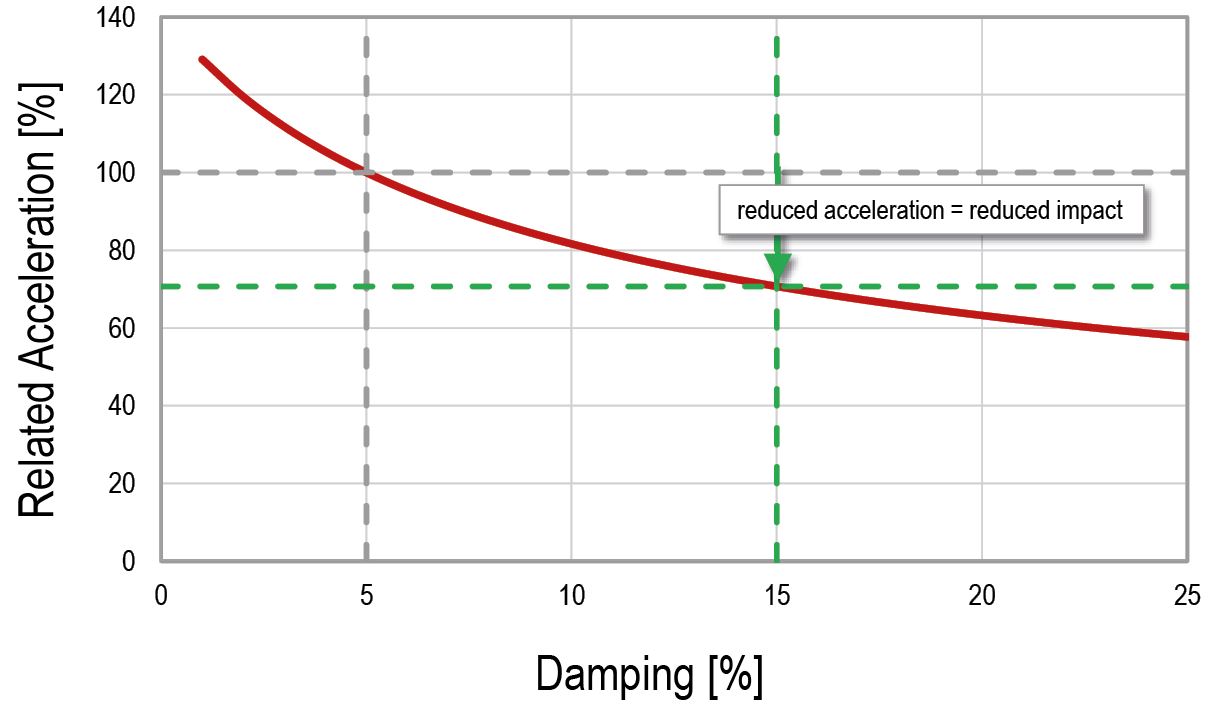
More than 80 years of GERB viscoelastic dampers (Viscodampers®)
Performance and variability
- Damping fluids with different viscosities are available for different load and ambient conditions to achieve the requested damping values for given requirements and broad temperature ranges
- For applications in nuclear facilities high radiation resistance is often required whereas outside applications require damping fluids with low temperature dependency
- GERB always strives to use the optimal damping fluid for each application and tests its tailormade solutions on in-house shaking tables
Certified solutions
- First patent for Viscodampers 1939
- TÜV certification since 1981
- Since then multiple design approvals from international certifing bodies
- Third party performance tests at facilities like BAM, MPA Karlsruhe, Fondazione Eucentre and UC San Diego
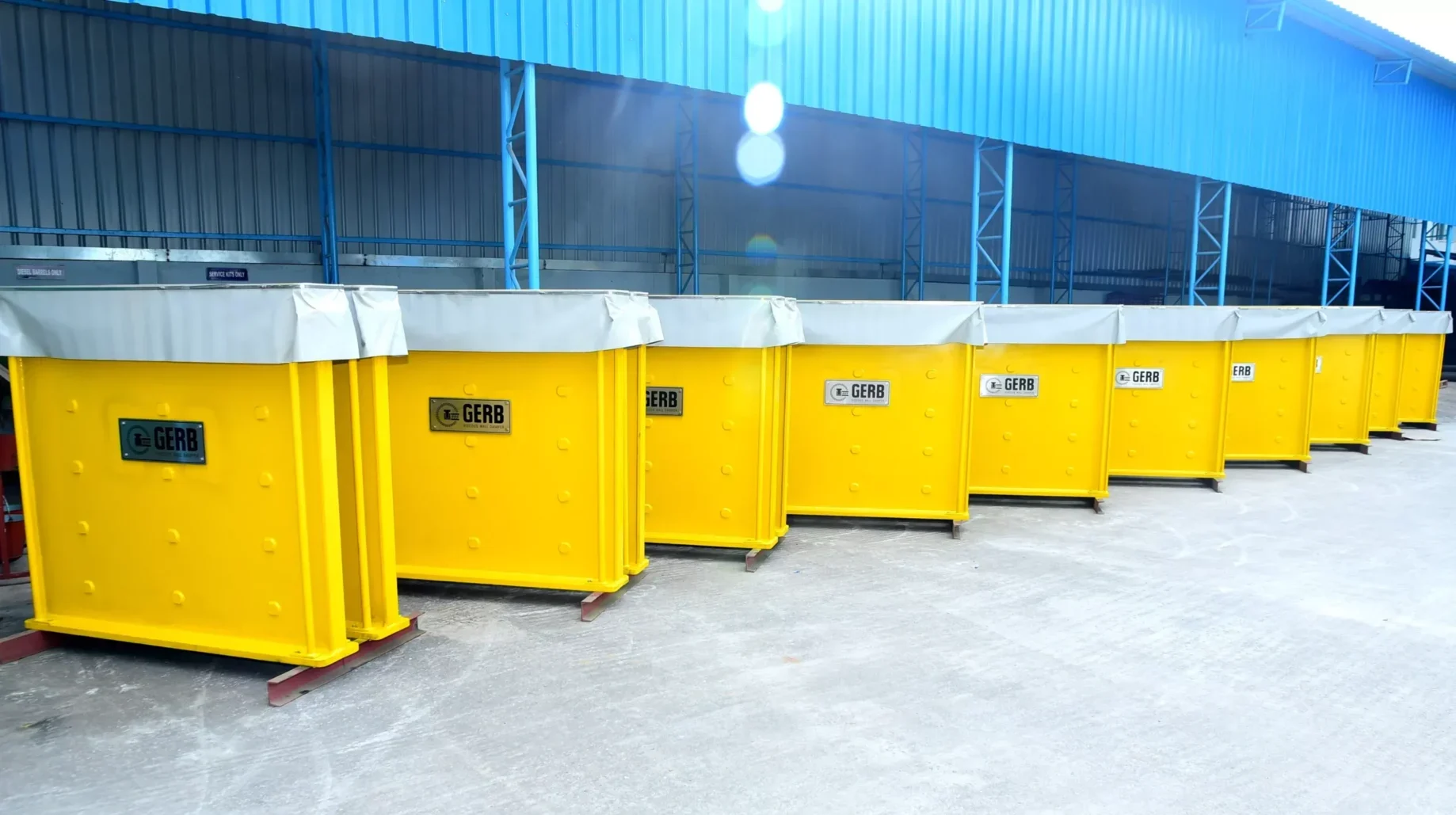
Further Resources
You need further information on this topic?
Please do not hesitate to contact us with your individual question.
One of our project engineers will get back to you shortly.
Earthquake Protection with GERB Viscous Wall Damper
Discussions as well as experience show that damping is a crucial factor to reduce the destructive potential of earthquakes. GERB Viscous Wall Dampers (GVWD) are a special design of common Viscodampers®. They are installed in buildings and structures connecting different floors addressing shear deformation between them. In this position they are especially reducing interstorey drift ratios during wind or seismic excitation.
Earthquake Protection with GERB Viscous Wall Damper
Discussions as well as experience show that damping is a crucial factor to reduce the destructive potential of earthquakes. GERB Viscous Wall Dampers (GVWD) are a special design of common Viscodampers®. They are installed in buildings and structures connecting different floors addressing shear deformation between them. In this position they are especially reducing interstorey drift ratios during wind or seismic excitation.
Seismic energy absorption through induced damping instead of intended damage
Earthquakes can have different effects on buildings depending on their duration, ground conditions and construction of the building. At the earth‘s surface, the earthquake waves cause the ground to move both horizontally and vertically. In particular, the horizontal forces released during earthquakes endanger the stability of structures. The consequences can be:
- Deformations and corresponding effects due to rapid movements from one direction to another
- Local damages (e.g. of non-structural elements like walls)
- Damaged doors and windows that can no longer be used
- Damage of important machinery where operation cannot be guaranteed
- No access to lifeline structures such as power or water
- Partial or complete collapse of the building
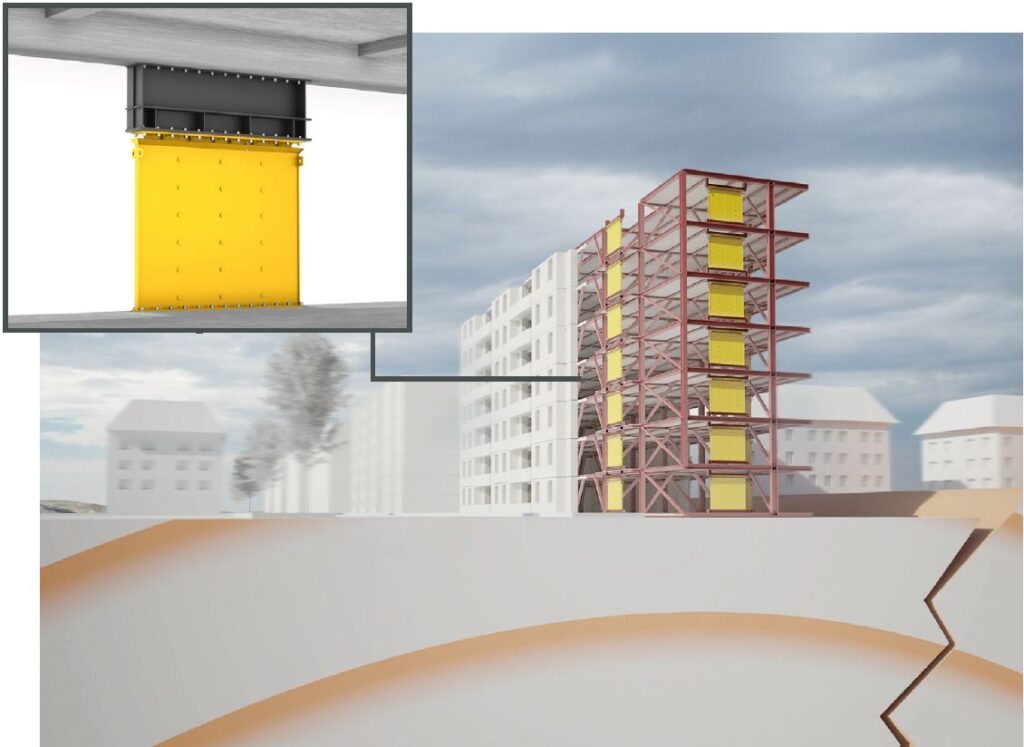
Seismic protection due to increase of damping
The main target of seismic construction standards is life safety. A safe evacuation of people must be guaranteed at all times. Appropriate construction measures help to significantly reduce the risk of collapse of a structure even during strong earthquakes. In addition, it is advisable to install seismic protection measures adapted to the conditions of structure and environment.
A damping solution using the latest technology can provide additional protection for structures in the event of an earthquake. The reduction of the induced structural responses by the increase of viscous damping can be taken from different national and international standards. Like illustrated in the figure, an increase of structural damping causes the reduction of the acceleration and thus of the earthquake impact on the structure. Seismic stress decreases with increase of damping.
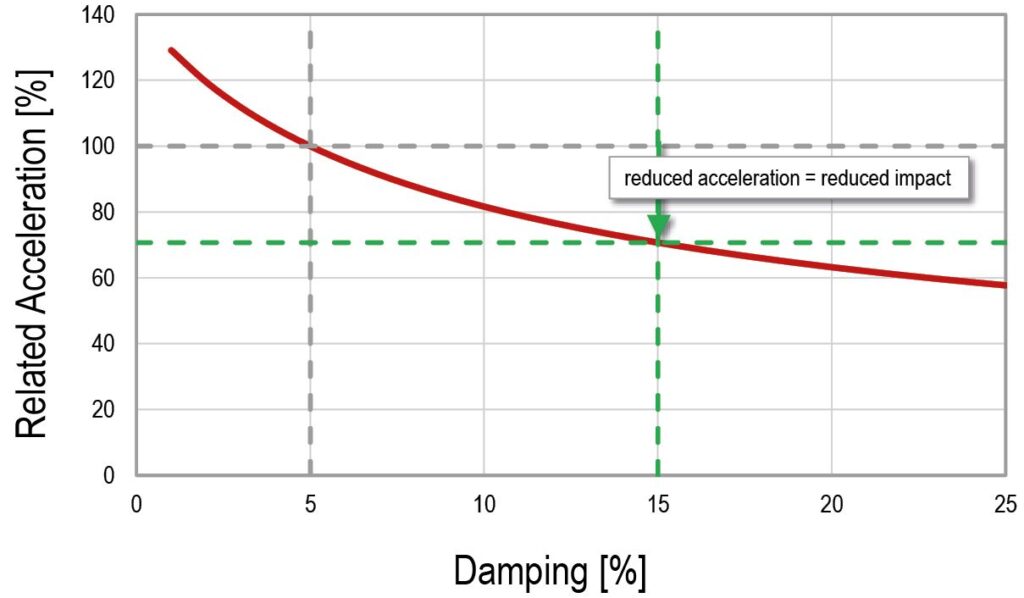
Seismic energy absorption through induced damping instead of intended damage
Earthquakes can have different effects on buildings depending on their duration, ground conditions and construction of the building. At the earth‘s surface, the earthquake waves cause the ground to move both horizontally and vertically. In particular, the horizontal forces released during earthquakes endanger the stability of structures. The consequences can be:
- Deformations and corresponding effects due to rapid movements from one direction to another
- Local damages (e.g. of non-structural elements like walls)
- Damaged doors and windows that can no longer be used
- Damage of important machinery where operation cannot be guaranteed
- No access to lifeline structures such as power or water
- Partial or complete collapse of the building

Seismic protection due to increase of damping
The main target of seismic construction standards is life safety. A safe evacuation of people must be guaranteed at all times. Appropriate construction measures help to significantly reduce the risk of collapse of a structure even during strong earthquakes. In addition, it is advisable to install seismic protection measures adapted to the conditions of structure and environment.
A damping solution using the latest technology can provide additional protection for structures in the event of an earthquake. The reduction of the induced structural responses by the increase of viscous damping can be taken from different national and international standards. Like illustrated in the figure, an increase of structural damping causes the reduction of the acceleration and thus of the earthquake impact on the structure. Seismic stress decreases with increase of damping.

More than 80 years of GERB viscoelastic dampers (Viscodampers®)
Performance and variability
Damping fluids with different viscosities are available for different load and ambient conditions to achieve the requested damping values for given requirements and broad temperature ranges
For applications in nuclear facilities high radiation resistance is often required whereas outside applications require damping fluids with low temperature dependency
GERB always strives to use the optimal damping fluid for each application and tests its tailormade solutions on in-house shaking tables
Certified solutions
- First patent for Viscodampers 1939
- TÜV certification since 1981
- Since then multiple design approvals from international certifing bodies
- Third party performance tests at facilities like BAM, MPA Karlsruhe, Fondazione Eucentre and UC San Diego
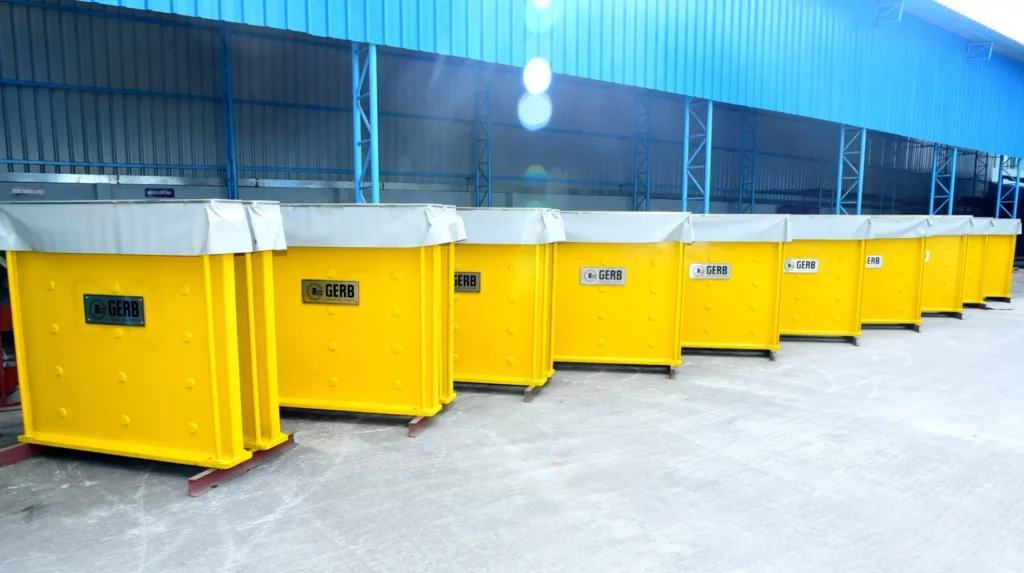
More than 80 years of GERB viscoelastic dampers (Viscodampers®)
Performance and variability
- Damping fluids with different viscosities are available for different load and ambient conditions to achieve the requested damping values for given requirements and broad temperature ranges
- For applications in nuclear facilities high radiation resistance is often required whereas outside applications require damping fluids with low temperature dependency
- GERB always strives to use the optimal damping fluid for each application and tests its tailormade solutions on in-house shaking tables
Certified solutions
- First patent for Viscodampers 1939
- TÜV certification since 1981
- Since then multiple design approvals from international certifing bodies
- Third party performance tests at facilities like BAM, MPA Karlsruhe, Fondazione Eucentre and UC San Diego

Share this post
Further Resources
You need further information on this topic?
Please do not hesitate to contact us with your individual question.
One of our project engineers will get back to you shortly.
Further Resources
You need further information on this topic?
Please do not hesitate to contact us with your individual question.
One of our project engineers will get back to you shortly.